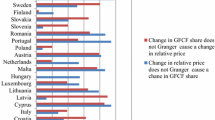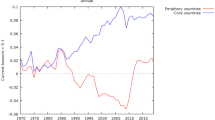Abstract
I expand Feldstein's (1983) model by including flexible exchange rate and by introducing endogenous fiscal policy. Using this model, I demonstrate how a positive investment-saving correlation can arise in a world with endogenous fiscal policy. I show that this correlation does not depend on capital mobility and therefore is compatible with any degree of capital mobility. This implies that the observed investment-saving comovement is not necessarily due to imperfect capital mobility. The model has a testable implication: it predicts a lack of Granger causality from private saving to private investment. Empirical examination of this prediction indicates that U.S. time series data is compatible with the hypothesis of endogenous fiscal policy during a flexible exchange rate period, but not during a fixed exchange rate period.
Similar content being viewed by others
References
Argimón, Isabel and José María Roldán (1994) “Saving, Investment, and International Capital Mobility in EC Countries,”European Economic Review 38, 59–67.
Banerjee, et al. (1993)Cointegration, Error-Correction, and the Econometric Analysis of Non-Stationary Data. Oxford: Oxford University Press.
Baxter, Marianne and Mario Crucini (1993) “Explaining Saving-Investment Correlations,”American Economic Review 83, 416–436.
Bayoumi, Tamim (1990) “Saving-Investment Correlations: Immobile Capital, Government Policy, or Endogenous Behavior?”International Monetary Fund Staff Papers 37, 360–387.
Caprio, Gerard, Jr., and David H. Howard (1984) “Domestic Saving, Current Accounts, and International Capital Mobility,”International Finance Discussion Paper No. 244, Board of Governors of the Federal Reserve System, June.
Congressional Budget Office (1985) ‘The Economic and Budget Outlook: Fiscal Years 1986–1990,” February.
Dooley, Michael, Jeffrey Frankel, and Donald J. Mathieson (1987) “International Capital Mobility: What Do Investment-Saving Correlations Tell Us?”International Monetary Fund Staff Papers 34, 503–530.
Engle, Robert and Clive Granger (1987) “Cointegration and Error-Correction: Representation, Estimation, and Testing,”Econometrica 55, 251–276.
Engle, Robert and B.S. Yoo (1991) “Cointegrated Economic Time Series: A Survey with New Results.” In Robert Engle and Clive Granger (eds.),Long-Run Economic Relationships: Readings in Cointegration. New York: Oxford University Press, pp. 237–266.
Evans, Paul (1987) “Interest Rates and Expected Future Budget Deficits in the United States,”Journal of Political Economy 95, 34–58.
Feldstein, Martin (1983) “Domestic Saving and International Capital Movement in the Long Run and the Short Run,”European Economic Review 21, 129–151.
Feldstein, Martin and Phillipe Bacchetta (1989) “National Saving and International Investment,” Working Paper No. 3164, National Bureau of Economic Research.
Feldstein, Martin and Charles Horioka (1980) “Domestic Saving and International Capital Flows,”The Economic Journal 90, 314–329.
Fieleke, N. (1982) “National Saving and International Investment.” InSaving and Government Policy, Conference Series No. 25. Federal Reserve Bank of Boston, pp. 138–157.
Frankel, Jeffrey A. and Alan T. MacArthur (1988) “Political vs. Currency Premia in International Real Interest Rate Differentials,”European Economic Review 32, No. 1083–1121.
Ghosh, Atish R. (1990) “International Capital Mobility and Optimal Current Account Behavior: An Empirical Investigation,” Discussion Paper No. 50, Department of Economics, Princeton University, February.
Gulley, O. David (1992) “Are Saving and Investment Cointegrated? Another Look at the Data,”Economics Letters 39, 55–58.
Johansen, Søren (1988) “Statistical Analysis of Cointegration Vectors,”Journal of Economic Dynamics and Control 12, 231–254.
Johansen, Søren and Katharina Juselius (1990) “Maximum Likelihood Estimation and Inference on Cointegration with Applications to the Demand for Money,”Oxford Bulletin of Economics and Statistics 52, 169–210.
Leachman, Lori (1991) “Saving, Investment, and Capital Mobility Among OECD Countries,”Open Economies Review 2, 137–163.
Levy, Daniel (1991) “Investment-Saving Comovement, Capital Mobility, and Fiscal Policy,” presented at the National Bureau of Economic Research, Universities Research Conference on Macroeconomic Effects of Fiscal Policy, March.
Levy, Daniel (1994) “Investment-Saving Comovement and Capital Mobility in the Past and Present,” Working Paper, Department of Economics, Emory University, April.
Levy, Daniel (1995). “Is Feldstein-Horioka Puzzle Really a Puzzle?” Working Paper, Department of Economics, Emory University, May.
MacKinnon, James G. (1991) “Critical Values for Cointegration Tests.” In Robert Engle and Clive Granger (eds.),Long-Run Economic Relationships: Readings in Cointegration. New York: Oxford University Press, pp. 267–276.
Miller, Stephen M. (1988) “Are Saving and Investment Cointegrated?”Economics Letters 27, 31–34.
Moreno, Ramon (1988) “Saving, Investment, and the U.S. External Balance,”Economic Review, Federal Reserve Bank of San Francisco, 4, 3–17.
Murphy, Robert G. (1984) “Capital Mobility and Relationship between Saving and Interest Rates in OECD Countries,”Journal of International Money and Finance 3, 327–342.
Obstfeld, Maurice (1986a) “Capital Mobility in the World Economy: Theory and Measurement,”Carnegie-Rochester Conference Series on Public Policy, 24, 55–104.
Obstfeld, Maurice (1986b) “How Integrated Are World Capital Markets: Some New Tests,” NBER Working Paper No. 2075.
Osterwald-Lenum, M. (1992) “A Note with Quantiles and Asymptotic Distribution of the Maximum Likelihood Cointegration Rank Test Statistics,” Oxford Bulletin of Economics and Statistics 54, 461–471.
Otto, Glenn and Tony Wirjanto (1989) “National Saving and Domestic Investment in the Long Run: Some Time Series Evidence for the U.S. and Canada,” Working Paper No. 754, Institute for Economic Research, Queen's University.
Pigott, Charles (1989) “Economic Consequences of Continued U.S. External Deficits,”Quarterly Review, Federal Reserve Bank of New York, Winter-Spring, 4–15.
Podivinsky, J. (1990) “Testing Misspecified Cointegrating Relationships,” Monash University Working Paper.
Roubini, Nouriel (1988) “Current Account and Budget Deficits in an Intertemporal Model of Consumption and Tax Smoothing,” unpublished manuscript.
Sargent, Thomas J. and Neil Wallace (1981) “Some Unpleasant Monetarist Arithmetics,”Quarterly Review, Federal Reserve Bank of Minneapolis, Fall, 1–17.
Summers, Lawrence (1988) “Tax Policy and International Competitiveness.” In Jacob Frenkel (ed.),International Aspects of Fiscal Policies, National Bureau of Economic Research Conference Report. Chicago: Chicago University Press, pp. 349–375.
Tesar, Linda (1991) “Saving, Investment, and International Capital Flows,”Journal of International Economics 31, 55–78.
Tobin, James (1983) “Domestic Saving and International Capital Movements in the Long-Run and the Short-Run” by M. Feldstein, Comment,European Economic Review 21, 153–156.
Westphal, Uwe (1983) “Domestic Saving and International Capital Movements in the Long-Run and the Short-Run” by M. Feldstein, Comment,European Economic Review 21, 157–159.
Wong, David Y. (1988) ‘What Do Saving-Investment Relationships Tell Us about Capital Mobility?” Working Paper No. 88-10, Federal Reserve Bank of Philadelphia.
Author information
Authors and Affiliations
Rights and permissions
About this article
Cite this article
Levy, D. Investment-saving comovement under endogenous fiscal policy. Open Econ Rev 6, 237–254 (1995). https://doi.org/10.1007/BF01000083
Issue Date:
DOI: https://doi.org/10.1007/BF01000083




